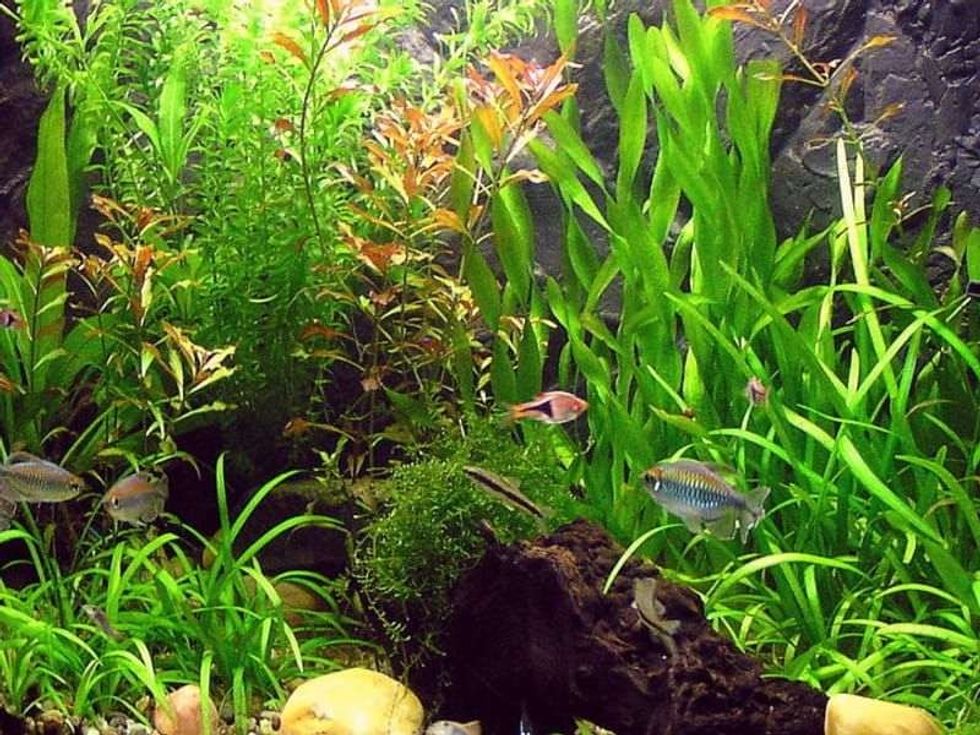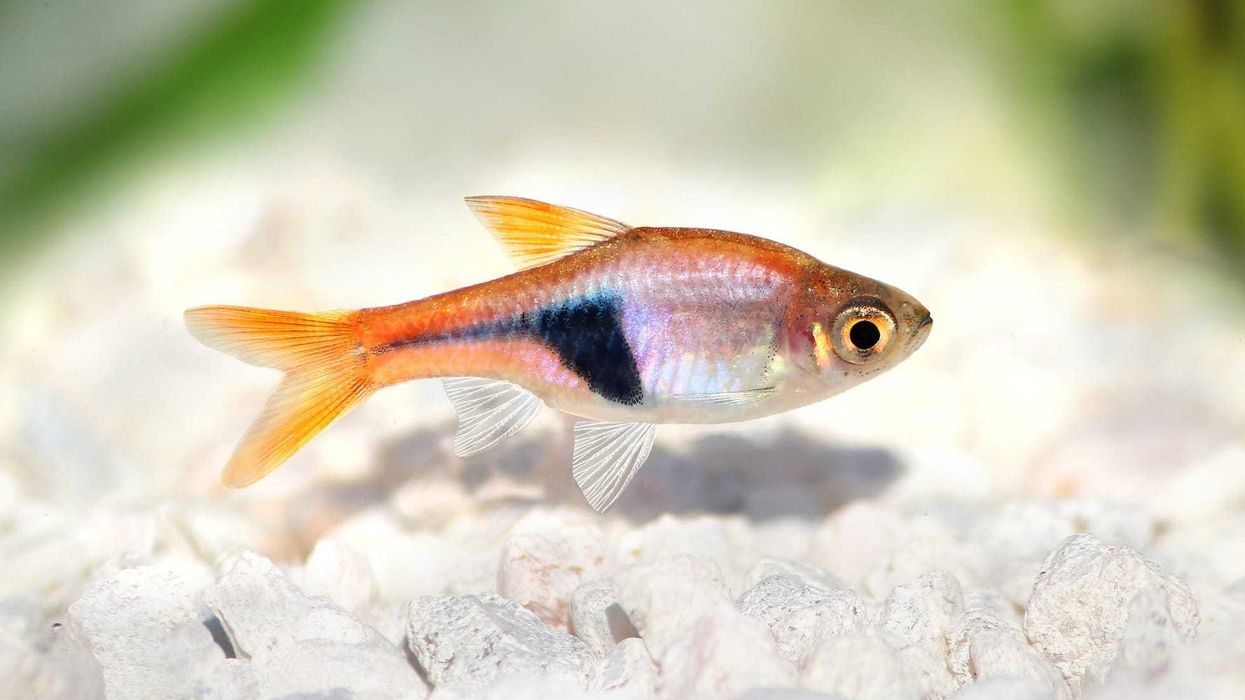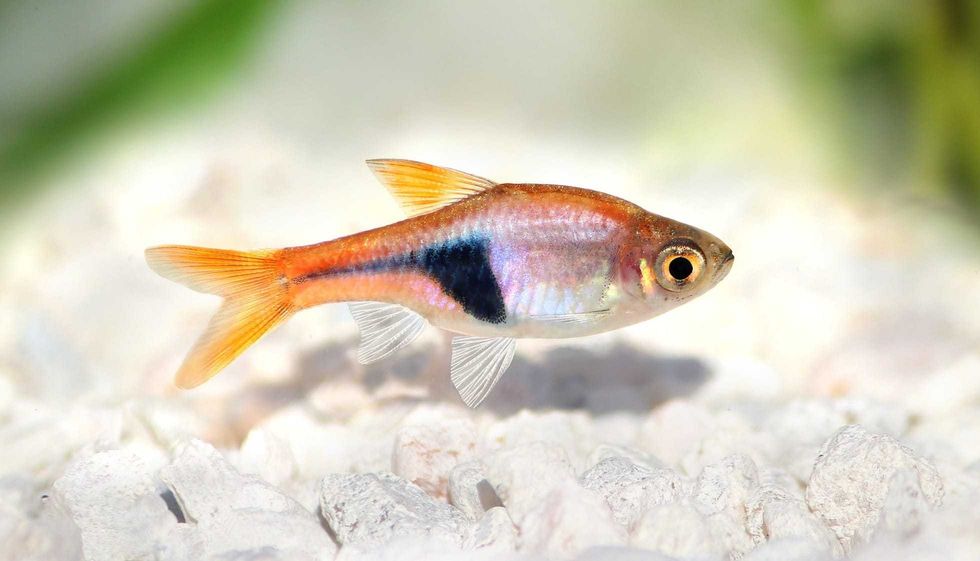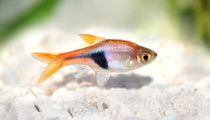Fun Harlequin Rasbora Facts For Kids

Content
- What type of animal is a harlequin rasbora?
- What class of animal does a harlequin rasbora belong to?
- How many harlequin rasboras are there in the world?
- Where does a harlequin rasbora live?
- What is a harlequin rasbora's habitat?
- Who do harlequin rasboras live with?
- How long does a harlequin rasbora live?
- How do they reproduce?
- What is their conservation status?
- What do harlequin rasboras look like?
- How cute are they?
- How do they communicate?
- How big is a harlequin rasbora?
- How fast can a harlequin rasbora swim?
- How much does a harlequin rasbora weigh?
- What are the male and female names of the species?
- What would you call a baby harlequin rasbora?
- What do they eat?
- Are they dangerous?
- Would they make a good pet?
- Did you know...
- Keeping your own harlequin rasbora
- Breeding harlequin rasboras
The harlequin rasbora, scientific name Trigonostigma heteromorpha, is a small, freshwater fish native to Southeast Asian countries like Malaysia, Thailand, Singapore, and Sumatra. The ideal water conditions of the habitat of these schooling fish are streams and other water bodies that have low mineral content and elevated levels of dissolved humic acids.
That makes swamped forest waters the perfect habitat for these peaceful fish species.
The harlequin rasbora, Trigonostigma heteromorpha, belonging to the family Cyprinidae prefers to live in the forest streams as the waterlogged soils contain decayed leaf litter. In the rainy season, this fish species is also found in shallow waters of flood plains.
Also known as red rasbora, this fish species is a favorite among aquarists because they adjust well to other peaceful tank mates, and are easy to care for. A harlequin rasbora school of fish looks stunningly pretty swimming around in an aquarium.
Male and female harlequin rasbora's size is almost the same. They have a slight difference in their appearance. The males have a thinner body compared to the females. Males have brighter red coloring in the dorsal fins and caudal fins. The females have a pale orange coloring.
You may also check out the fact files on milkfish and amberjacks from Kidadl.
Harlequin Rasbora Interesting Facts
What type of animal is a harlequin rasbora?
Harlequin rasboras, Trigonostigma heteromorpha, is a species of popular freshwater schooling fish endemic to Southeast Asian countries. The shimmering silver-red color and black markings make them beautiful aquarium fishes.
What class of animal does a harlequin rasbora belong to?
Belonging to the class Actinopterygii, harlequin rasboras are peaceful shoaling fish that can live in the wild and as aquarium fish.
How many harlequin rasboras are there in the world?
It is difficult to say how many harlequin rasboras are there in the world. These small fish have a healthy population in the wild as well as in aquariums. As shoaling fish, they do well in large groups. However, they can stay in pairs or small groups of four or five pars in a sizable aquarium.
Where does a harlequin rasbora live?
In the wild, the Trigonostigma heteromorpha prefers densely vegetated, slow-moving, peaty water. In captivity, they can live in all kinds of tanks with the tank mates of their species or other peaceful fish species.
When setting up a tank for harlequin rasboras, it is important to remember, they like dark, slightly sandy, or gravel-filled substrate. It is important to add plenty of leafy accumulation to the tank. Rocks, real driftwood pieces, and live plants are ideal accessories in a harlequin rasbora aquarium.
These small, docile, peaceful fish prefer swimming in highly vegetated waters and are extremely easy to maintain. They breed and live in harmony with their young without human help.
This species fits well in aquariums with several other species like tetras, bettas, barbs, dwarf gouramis, and other small rasboras. These small fish may be attack victims of bigger or other aggressive species.
What is a harlequin rasbora's habitat?
All rasbora species like the scissortail, harlequin, ray-finned lambchop or the false harlequin rasbora, lamprey or emerald eye, and the brilliant rasboras are fish of the true freshwater family. These fish are always found in freshwater sources and never in brackish waters.
There are more than a dozen of rasbora species with varied appearances. Most have a similar preference for water conditions, dark color substrate, dense vegetation, and subdued lighting in tanks. Most of the rasbora species have striking coloration and unique patterns on their body.
The purple harlequin rasbora or Trigonostigma heteromorpha has a striking purple color that gives this fish a distinctive look. The black harlequin rasbora has a bluish-black body and orange head. They have a triangle patch near the dorsal fin. Most of the harlequin rasboras are popular aquarium fish and fit well in medium-sized tanks.
Like their natural tropical lowland water habitat, rasbora prefers soft and near-neutral pH of 5.0 to 7.0, slightly warm water 72°F - 79°F. Harlequins need space to swim around and prefer saying in a group.
Rocks, sand, debris, driftwood are part of their natural habitat. When kept in tanks, these accessories help the fish to feel at home.
Who do harlequin rasboras live with?
Rasboras belong to the family Cyprinidae and are related to barbs, koi, danios, and goldfish. In their wild habitat, harlequin rasboras live in loose social groups.
In aquariums at least eight to ten fish of the same species must be kept together for them to feel safe. Keeping harlequin rasboras in large groups in tanks shows their true color in a literal sense.
This happens as the males compete for the attention of females during the breeding season. Breeding this fish in aquariums that are healthy, well-cycled, densely filled with plants is common.
These small community fish adjust well with some other slightly larger species in tanks like labyrinth fish like sparkling gourami, and the dwarf gourami. Also, pentazona barbs, guppies, angelfish, zebrafish, bottom dwellers like corydoras catfish, loaches, and kuhli, and some danio fish species are good tank mates for rasboras.
It is easy to keep fish with other community fish varieties as they are omnivorous and not too choosy about their foods. Harlequin rasboras cannot be housed with dwarf freshwater shrimp or else the shrimp will soon become food.
How long does a harlequin rasbora live?
Harlequin rasboras can live for five to eight years if kept in healthy tanks and fed proper live and dry foods.
How do they reproduce?
Given the right water conditions, like the pH level and temperature, a thick cover of plants, and the right nutritional foods, it is not difficult to breed harlequin rasboras in tanks. They just require similar conditions as their wild habitat.
Feed the omnivorous harlequin rasboras fish flake foods, brine shrimp, or pellets. However, for good health and bright coloration, and breeding, these fish need to be fed some live or frozen meaty foods like bloodworms, brine shrimp, insect larvae, and daphnia.
What is their conservation status?
The conservation status of the harlequin rasbora is of Least Concern according to the IUCN.
Harlequin Rasbora Fun Facts
What do harlequin rasboras look like?

Rasboras are of different kinds and the harlequin rasbora is one the most popular with aquarium enthusiasts. It is also called the red rasbora, due to its reddish-copper-colored body.
The rear half of the body is accented with an eye-catching, distinct triangular, black wedge. This black patch starts near the dorsal fin and stretches to the base of the caudal fin. It gets narrower as it elongates towards the tail base.
The harlequin rasbora has a similarity in appearance to rasbora espei or the lambchop rasbora, which is also known as false harlequin rasbora. The R. hengeli, or the ‘glowlight’ rasbora, also has a striking similarity to the harlequin rasbora species.
The harlequin rasbora has a diamond or lozenge-shaped body that tapers dramatically towards the tail. The body has a silvery sheen and is covered in an orange-pink hue. The wedge-shaped black patch on the body creates a fantastic visual contrast.
The male’s black marking on the body aligns with the dorsal fin. In the males, the black stripe on their body extends well up to the tail. In the male fish, the two anal fins are located close to each other. In the female fish, these fins are separated with a larger gap.
The males of this species reveal a rounded extension at the edge of the distinctive black wedge that covers the posterior of the fish. In females, it is completely straight. The female harlequin rasbora is also larger than the male.
How cute are they?
Rasbora species of fish are small, friendly, peaceful, and colorful. They look adorable in aquariums.
How do they communicate?
Rasboras are schooling fish and live in large groups in the wild. They have different kinds of bodily movements for different situations. When they are frightened, they hide in between dense aquatic plants. During the breeding season, the male and female communicate with different bodily movements to signal their mates.
How big is a harlequin rasbora?
Harlequin rasboras in the wild and aquariums grow up to a length of 1.4-1.8 in (3.5-4.5 cm) which is almost thirteen times smaller than a goldfish’s length in the wild. Goldfish can grow up to 14 in (35.56 cm) in the wild and up to 6 in (15.2 cm) in aquariums.
How fast can a harlequin rasbora swim?
Harlequin rasboras are mid-level swimming fish that can move fast from one end of a tank to the other. Their swimming speed has not been recorded.
How much does a harlequin rasbora weigh?
Rasboras are small fish and their exact weight is difficult to say.
What are the male and female names of the species?
Male and female harlequin rasboras do not have any specific names.
What would you call a baby harlequin rasbora?
A baby rasbora is called a fry.
What do they eat?
Harlequin rasboras are easy to care for as they are not extremely picky eaters. These omnivorous fish species eat a wide range of foods. Along with the type of the food, the size of the flake foods, and live foods should be cared about.
Since rasboras have tiny mouths they can only eat small pieces. In the wild, their diet is restricted to foods like plant accumulations, small insect eggs, and insect larvae. These opportunistic eaters include plant and live food in their diet according to availability.
When placed in aquariums the easiest way to keep them fed is to give them store-bought food. However, some meaty food, like small worms, brine shrimp, or daphnia are required for coloration and breeding.
When food is placed in the tank, these fish become highly active and feed on pellets from the surface of the tank. To meet their nutritional requirement it is best to offer them a mix of pellet foods and live foods.
Are they dangerous?
No, harlequin rasboras are friendly, freshwater fish that are not dangerous at all.
Would they make a good pet?
Harlequin rasboras are freshwater fish that make wonderful aquarium pets. These gentle and friendly community-oriented fish can live in large groups of their kind and also with other non-aggressive fish. They like lots of plants, rocks, and vegetative material in their tanks.
Harlequin rasboras are a global favorite of aquarists. At least four to six of these shoaling fish should be kept together to provide them with a healthy life.
With larger groups, the color display becomes better. It is all right to keep these fish in a ten-gallon tank with two for every gallon as these fish require enough space to swim.
Caring for harlequin rasboras is easy as they are low-maintenance fish. The most important thing to care for is the temperature and the pH of the water in the tank.
Did you know...
There are more than a dozen of rasbora species. Here are some rasbora facts about them.
The galaxy rasboras, or the celestial pearl danio, is one of the most colorful rasboras. The base body color of this fish species resembles the night sky’s deep blue hue.
The tiny chili rasboras are tiny fish (smaller than an inch long) with bright red and blue coloring. This species native to South West Borneo, Indonesia is also called mosquito rasbora.
Clown rasboras are another peaceful fish that can do well in a community setting. However, choosing appropriate tank mates can be tough due to the fish’s unique needs.
The dwarf rasbora also called the pygmy rasbora is the smallest member of the Cyprinid family. This fish grows to less than half an inch in size. It has three distinct black spots on its pale pink, shiny body. The males are often ruby-red.
Keeping your own harlequin rasbora
Harlequin rasboras are small yet hardy fish. A ten-gallon tank can accommodate around twenty fish. With proper care, water conditions, plant cover, and food these prove to be low-maintenance fish.
Common fish diseases like dropsy, ich, and fin rot may affect these freshwater fish. Cleaning their tanks regularly is recommended.
Breeding harlequin rasboras
A couple of young harlequins can be kept for breeding in one aquarium. It is better to keep one male with a pair of females.
The male will get a chance to entice the opposite sex and show its beautiful colors. A pregnant female has a deeper belly than a male. For breeding, some broad-leaved plants are required inside the breeding tank as the eggs will finally get attached to them.
In a breeding tank, the spawning will usually happen in the morning. The male initiates the process by dancing with wobbly movements before the female.
This is a gesture to direct the female to a suitable plant location for depositing the eggs. The male may guide the female to the spawning location by rubbing its body against the female’s back.
When the female is ready to spawn or lay eggs, it will signal by rubbing its belly on the underside of leaves. The male will then approach with the trembling movement to fertilize the eggs as they are released.
The rows of eggs will remain attached to the underside of the leaves for about a day before they hatch. An average of six to twelve eggs is released at a time.
As they are fertilized, the eggs rise and stick to the leaves of the aquatic plants. The female continues to release the eggs in intervals and may lay as many as three hundred in a breeding season. However, usually, 80-100 eggs are laid in tanks.
When breeding in tanks, it is important to remove the adults once the spawning is complete. Or else, they will eat the fry or the young fish when they hatch. Harlequin rasbora eggs hatch in about 24 hours.
The translucent fries remain adhered to the leaf for half a day to one day while the yolk sac is absorbed by their body for nutrition.
When the process is complete, the young fish are free to swimming. For the next couple of weeks, the fry feeds on very small foods like live aquatic creatures like infusoria or specially prepared commercial food for fry. After that, they are ready to feed upon young brine shrimp.
Harlequin rasboras reach sexual maturity when they are about six to nine months old.
Here at Kidadl, we have carefully created lots of interesting family-friendly animal facts for everyone to discover! For more relatable content, check out these cory catfish facts and Arowana facts for kids!
You can even occupy yourself at home by coloring in one of our free printable Harlequin Rasbora coloring pages.
We Want Your Photos!
More for You
See All
Bachelor of Science specializing in Microbiology

Oluwatosin MichaelBachelor of Science specializing in Microbiology
With a Bachelor's in Microbiology from the Federal University of Agriculture, Abeokuta, Ogun State, Oluwatosin has honed his skills as an SEO content writer, editor, and growth manager. He has written articles, conducted extensive research, and optimized content for search engines. His expertise extends to leading link-building efforts and revising onboarding strategies.
Postgraduate Diploma in Management

Sakshi RaturiPostgraduate Diploma in Management
Sakshi has experience in marketing strategy, social media planning, and recruiting industry experts for capstone projects, she has displayed a commitment to enhancing their skills and knowledge. She has won multiple awards, including a Certificate of Appreciation for Creative Writing and a Certificate of Merit for Immaculate Turut, and is always seeking new opportunities to grow and develop.
Disclaimer
1) Kidadl is independent and to make our service free to you the reader we are supported by advertising. We hope you love our recommendations for products and services! What we suggest is selected independently by the Kidadl team. If you purchase using the Buy Now button we may earn a small commission. This does not influence our choices. Prices are correct and items are available at the time the article was published but we cannot guarantee that on the time of reading. Please note that Kidadl is a participant in the Amazon Services LLC Associates Program, an affiliate advertising program designed to provide a means for sites to earn advertising fees by advertising and linking to Amazon. We also link to other websites, but are not responsible for their content.
2) At Kidadl, we strive to recommend the very best activities and events. We will always aim to give you accurate information at the date of publication - however, information does change, so it’s important you do your own research, double-check and make the decision that is right for your family. We recognise that not all activities and ideas are appropriate for all children and families or in all circumstances. Our recommended activities are based on age but these are a guide. We recommend that these ideas are used as inspiration, that ideas are undertaken with appropriate adult supervision, and that each adult uses their own discretion and knowledge of their children to consider the safety and suitability. Kidadl cannot accept liability for the execution of these ideas, and parental supervision is advised at all times, as safety is paramount. Anyone using the information provided by Kidadl does so at their own risk and we can not accept liability if things go wrong.
3) Because we are an educational resource, we have quotes and facts about a range of historical and modern figures. We do not endorse the actions of or rhetoric of all the people included in these collections, but we think they are important for growing minds to learn about under the guidance of parents or guardians.







